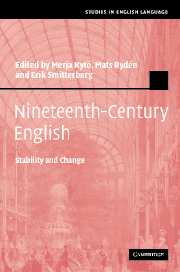Book contents
- Frontmatter
- Contents
- List of plates
- List of figures
- List of tables
- List of contributors
- Acknowledgements
- Introduction: Exploring nineteenth-century English – past and present perspectives
- 1 Modifiers describing women and men in nineteenth-century English
- 2 Words in English Record Office documents of the early 1800s
- 3 The subjunctive in adverbial clauses in nineteenth-century English
- 4 The passive in nineteenth-century scientific writing
- 5 Relativizers in nineteenth-century English
- 6 Anaphoric reference in the nineteenth century: that/those + of constructions
- 7 Adjective comparison in nineteenth-century English
- 8 Nonfinite complement clauses in the nineteenth century: the case of remember
- 9 The in -ing construction in British English, 1800–2000
- 10 Partitive constructions in nineteenth-century English
- Appendix
- References
- Name index
- Subject index
5 - Relativizers in nineteenth-century English
Published online by Cambridge University Press: 22 September 2009
- Frontmatter
- Contents
- List of plates
- List of figures
- List of tables
- List of contributors
- Acknowledgements
- Introduction: Exploring nineteenth-century English – past and present perspectives
- 1 Modifiers describing women and men in nineteenth-century English
- 2 Words in English Record Office documents of the early 1800s
- 3 The subjunctive in adverbial clauses in nineteenth-century English
- 4 The passive in nineteenth-century scientific writing
- 5 Relativizers in nineteenth-century English
- 6 Anaphoric reference in the nineteenth century: that/those + of constructions
- 7 Adjective comparison in nineteenth-century English
- 8 Nonfinite complement clauses in the nineteenth century: the case of remember
- 9 The in -ing construction in British English, 1800–2000
- 10 Partitive constructions in nineteenth-century English
- Appendix
- References
- Name index
- Subject index
Summary
Introduction
This study analyses the use of relativizers in nineteenth-century English, and the distribution of wh-forms (who, whose, whom and which) and that in particular. The data are drawn from CONCE (A Corpus of Nineteenth-century English; see Kytö, Rudanko and Smitterberg 2000, and the Introduction to this volume). Three genres, very different in character, were analysed: Science, Trials and Letters. Time periods 1 and 3 were studied in order to detect a change in the use of relativizers, mainly in the distribution of the wh-forms and that.
In Middle English and Early Modern English, frequent use is made of the relativizer that regardless of the type of antecedent and the type of relative clause (Barber 1997: 209–16). In the fifteenth century, which (or the form the which), as an alternative to that occurs for example in prepositional relative constructions (see Fischer 1992: 296–8, 388–90 and Johansson 2002), but who is not widely used, outside certain idiolects, until the beginning of the eighteenth century (Rydén 1966: 3–4, 279–80; 1983). In Present-day English (primarily American English), the relativizer that is used chiefly in restrictive relative clauses, whereas which in particular is very rare in this type of clause (see Geisler and Johansson 2002). The results of the present study show that in nineteenth-century English, at least in the genres studied here, it is the wh-forms that are used much more frequently, in restrictive and nonrestrictive relative clauses, than the relativizer that.
- Type
- Chapter
- Information
- Nineteenth-Century EnglishStability and Change, pp. 136 - 182Publisher: Cambridge University PressPrint publication year: 2006
- 2
- Cited by



